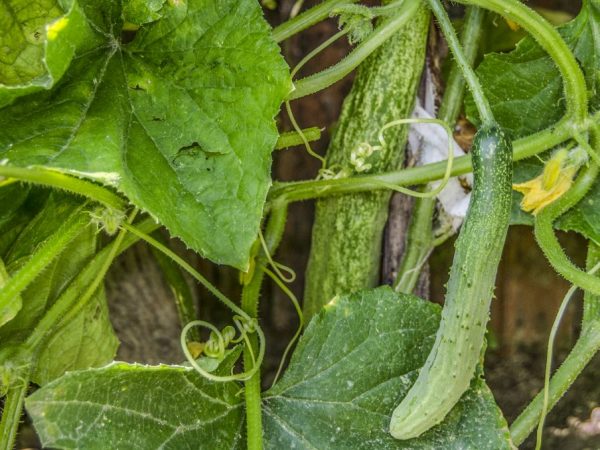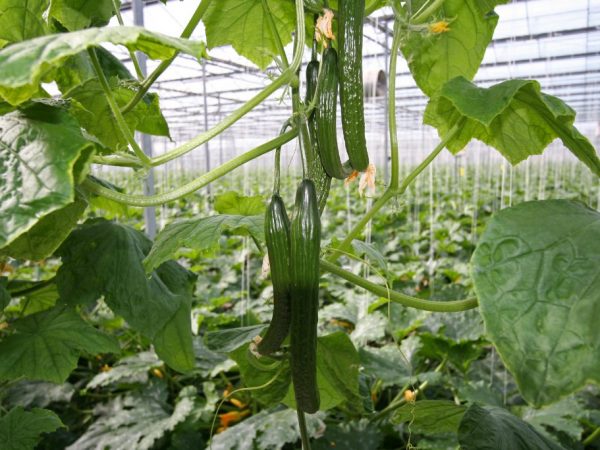Characteristics of the variety of cucumbers Chinese snakes
The variety of cucumbers Chinese snakes have completely conquered the hearts of domestic vegetable growers. What could be better than crispy, aromatic, long fruits in early summer that do not require undue effort to grow.

Characteristics of the variety of cucumbers Chinese snakes
Description of the variety
Cucumber Chinese snake is distinguished by its excellent taste and unpretentious care.
The description of the variety is as follows:
- fruits are long, wriggling, in shape reminiscent of a snake, their length is from 40 to 80 cm; they are juicy, with a thin skin;
- the stem is long, up to 3.5 m in height, with a small number of lateral shoots;
- yield - up to 30 kg / sq. m.
The bush requires a high trellis, without it the fruits are deformed and grow unsightly. The culture grows well in shady beds, is not afraid of temperature changes, and in open ground conditions it bears fruit until mid-autumn, until the night air temperature drops below 6 ° C. The fruits grow very quickly, so they must be picked every day. They are not stored for long, they quickly lose marketability, so you need to tear as much as necessary for consumption. Overgrown cucumbers are long, sometimes reaching 1 m, they become lethargic and bitter in taste.
The culture is bee-pollinated, the number of female flowers prevails on it, so insects should be attracted to the bushes. The best harvest can be achieved in a greenhouse, but in open field conditions, the crop also bears fruit well.
Advantages and disadvantages
Like any variety, the crop has advantages and disadvantages.
The advantages of the Chinese snake are:
- fast growth of fruits;
- the density of the cucumbers;
- unpretentious care;
- good tolerance to low temperatures;
- fruiting for 5 months.
Growing a Chinese snake does not require any special costs.
Among the disadvantages are the short shelf life, the need to install a high trellis, the unstable germination of seeds and the suitability for fresh consumption.
Planting cucumbers
The seeds of this culture, as mentioned above, do not sprout amicably and are difficult to hatch, so they are recommended to first be sown in cups or seedling boxes. Before planting, the seeds are disinfected in a solution of potassium permanganate (35 ° C) for 10 minutes. After that, they are treated with trichodermine.
A month after the appearance of the first shoots, the sprouts are transplanted to a permanent place. The strongest plants should be planted, the weak ones will disappear during transplantation.
Soil preparation
The substrate for seedling boxes or cups is purchased in the store or prepared. It should consist of soil, fine peat and manure. The self-prepared substrate is treated with a fungicide or disinfected with a solution of potassium permanganate. The mixture bought in the store has already been disinfected; there is no need to repeat the procedure.
The area for cucumbers is prepared in the fall. Favorable predecessors of the culture are pumpkin plants, potatoes, corn, legumes. Do not use an area where cucumbers were grown last year.This will contribute to the spread of diseases and pests; it will not be possible to get a good harvest.
Manure is added to the garden bed where the cucumbers will be placed. The soil is dug deeply and loosened.
Sowing
Seedlings are sown in the last decade of April. It is planted in open ground in a month, in late May or early June.
The bushes of the culture are powerful, so they should be rarely planted. The recommended planting scheme is 50 x 100. The soil must be moistened and loosened before planting seedlings.
In the open field, in the first 2 weeks, the garden bed is covered overnight with agrofibre or film. Temperatures below 6 ° C at night can be detrimental to seedlings. After 2 weeks, the shelter can be removed.
Care

The plant needs support
The culture is unpretentious in care, requires timely watering, loosening the soil, removing weeds and dressing, like other types of cucumbers. The bush requires a high and stable trellis, the plant will curl along it, like a liana.
Cucumbers of this variety grow quickly, with many leaves and side shoots being formed. They can also bear fruit. If this happens, the fruits intertwine, interfere with each other, and rot. This is the main reason why experienced gardeners remove leaves and side shoots. If pruning is done, the main lash will be more powerful and the fruits will be able to grow without interfering with each other.
Watering
The fruits grow very quickly, a large bush has strong roots, therefore it requires regular watering with warm water. The culture simply does not tolerate cold water. It is better to use drip or sprinkler irrigation, as the water jet washes the roots out of the soil.
In open field conditions, plants are watered twice on very hot days. On the south side, it is best to shade the garden with tall neighboring crops: corn, climbing legumes, etc. In this case, the crop will not dry out from the heat.
Insufficient watering leads to a loss of taste, the fruits begin to taste bitter. Waterlogging causes root rot of cucumbers.
Fertilizer
The plant bears fruit rapidly, therefore it requires constant feeding. The first time fertilizers are applied 7-10 days after transplanting.
Experienced gardeners carry out the first feeding with bread infusion. It is prepared in the following way: dry bread crusts are poured with warm water and wait until they are completely soaked and a homogeneous thick liquid is formed. Cucumbers are watered with it, which brings excellent results. Carrying out the next feeding every 10 days.
Fertilizers are alternated in this way:
- urea solution (1 tablespoon per 10 liters of water);
- manure solution.
The mullein solution is prepared as follows: fresh manure and water (1: 3) are taken, left to ferment for a week. The slurry is constantly stirred. When feeding on a bucket of water, give 1 liter of liquid manure and 50 g of superphosphate. It is poured into the prepared grooves at the aisles, then the furrows are buried.
With the same solution, but 2 times less concentrated, foliar dressing is carried out.
Pest control
The culture is resistant to most disease states.
It is not recommended to shift cucumber lashes, the leaves will still turn to the sun, but the plant will experience stress.
Sick and dry leaves are cut off without leaving stumps so that the cut site does not get wet, otherwise powdery mildew may develop. The leaves are cut in the morning, then the cut sites dry up in the evening.
Conclusion
Growing a Chinese snake is a real pleasure for vegetable growers. It allows you to provide the whole family with juicy, tender cucumbers throughout the summer and half of autumn.


